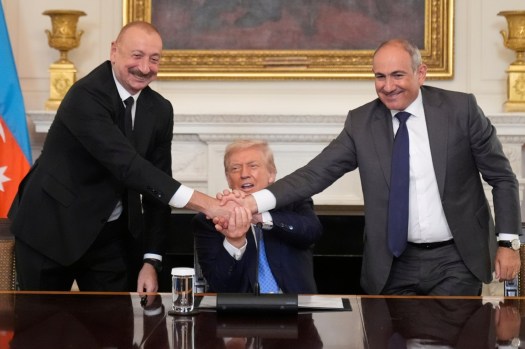Armenia and Azerbaijan Forge Historic Peace Deal at White House, Opening Key Transit Routes
In a landmark moment for the South Caucasus region, leaders of Armenia and Azerbaijan shook hands at a White House peace summit on Friday, marking a significant step towards resolving decades of conflict. The agreement, facilitated by U.S. diplomatic efforts, aims to reopen vital transportation routes and reduce tensions between the two nations, while also capitalizing on Russia"s diminishing influence in the area.
Background & Context
The relationship between Armenia and Azerbaijan has been fraught with conflict for over a century, primarily centered around the disputed region of Nagorno-Karabakh. Following a brutal war in 2020 that resulted in thousands of casualties and significant territorial changes, the need for a diplomatic resolution became increasingly urgent. The White House summit represents a culmination of efforts by U.S. officials to mediate a lasting peace, reflecting a broader strategy to enhance American influence in a region traditionally dominated by Russia.
This peace summit is particularly notable as it coincides with a broader geopolitical shift, where the U.S. is seeking to assert its role amidst declining Russian authority in the region. The agreements signed at the summit include the establishment of a major transit corridor, aptly named the "Trump Route for International Peace and Prosperity," designed to facilitate trade and movement between the two countries.
Key Developments
During the summit, Armenian Prime Minister Nikol Pashinyan and Azerbaijani President Ilham Aliyev each signed agreements that outline the re-opening of key transportation routes previously closed due to conflict. The U.S. government, represented by senior officials, played a crucial role in negotiating the terms of this historic deal, which also includes commitments to uphold peace and promote economic collaboration between the neighboring nations.
"Today marks a new chapter in the relationship between Armenia and Azerbaijan," said U.S. Secretary of State Antony Blinken during the signing ceremony. "This agreement not only opens new pathways for trade and travel but also paves the way for a more stable and prosperous future for both nations." The deal is seen as a vital step in fostering cooperation and dialogue, with the U.S. poised to act as a facilitator moving forward.
\n\n
Image for Armenia and Azerbaijan Forge Historic Peace Deal at White House, Opening Key Transit Routes
Broader Impact
The implications of this agreement extend far beyond the immediate benefits of reopened routes. Experts suggest that the deal could significantly reshape the geopolitical landscape of the South Caucasus. With Russia"s influence waning, the United States may find new opportunities to strengthen its alliances and partnerships in the region, potentially altering the balance of power that has persisted for decades.
Additionally, the agreement has sparked optimism among local populations who have long suffered from the repercussions of conflict. Economic analysts predict that the re-establishment of transport links could lead to increased trade, investment, and ultimately, stability in a region that has historically been marred by violence. "This is a turning point," said Dr. Leila Aslanova, a geopolitical expert at the University of Baku. "If implemented effectively, the agreement could lead to a more integrated and economically viable South Caucasus." This sentiment echoes the hopes of many within both nations.
What"s Next
As the dust settles from the historic summit, the focus now shifts to the implementation of the agreements and the establishment of the Trump Route. Both governments will need to ensure that the commitments made are honored and that the public is engaged in the peace-building process. Immediate steps include the formation of joint committees to oversee the reopening of transportation routes and address any emerging disputes.
Moreover, the international community will be watching closely, with the potential for increased U.S. involvement in the region as a stabilizing force. Analysts suggest that continued diplomatic engagement will be essential to maintain momentum and ensure that the peace process does not falter. As previously reported, the shifting dynamics in the region may also prompt neighboring countries to reassess their own diplomatic strategies and alliances, potentially leading to a broader regional realignment in the years to come.
With the signing of this agreement, Armenia and Azerbaijan stand at a crossroads, filled with both challenges and opportunities that could redefine their futures and the geopolitical landscape of the South Caucasus.

Image for Armenia and Azerbaijan Forge Historic Peace Deal at White House, Opening Key Transit Routes








![[Video] Vladimir Putin delivers speech in military uniform](/_next/image?url=%2Fapi%2Fimage%2Fthumbnails%2Fthumbnail-1764621642413-vh08a-thumbnail.jpg&w=3840&q=75)